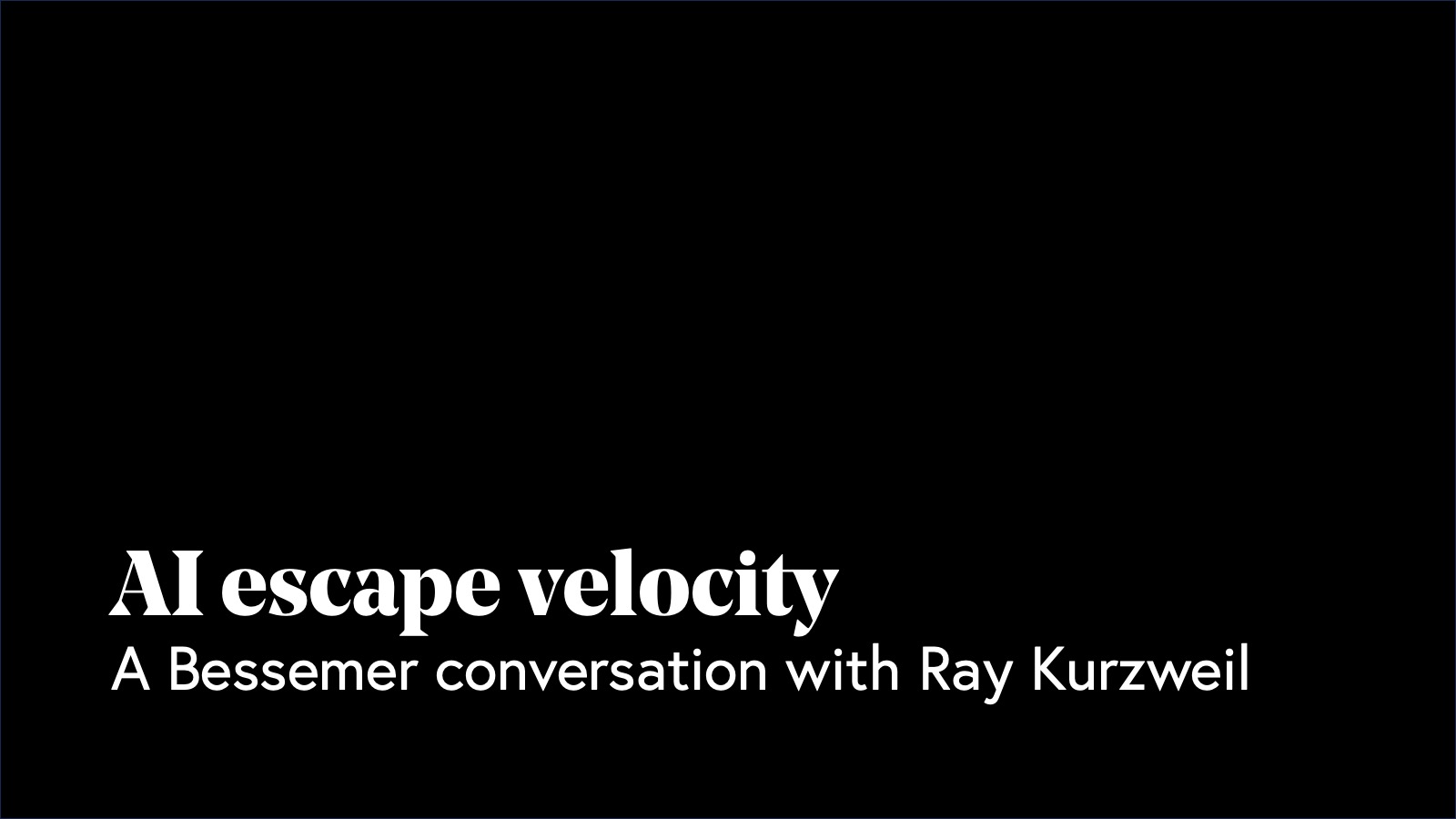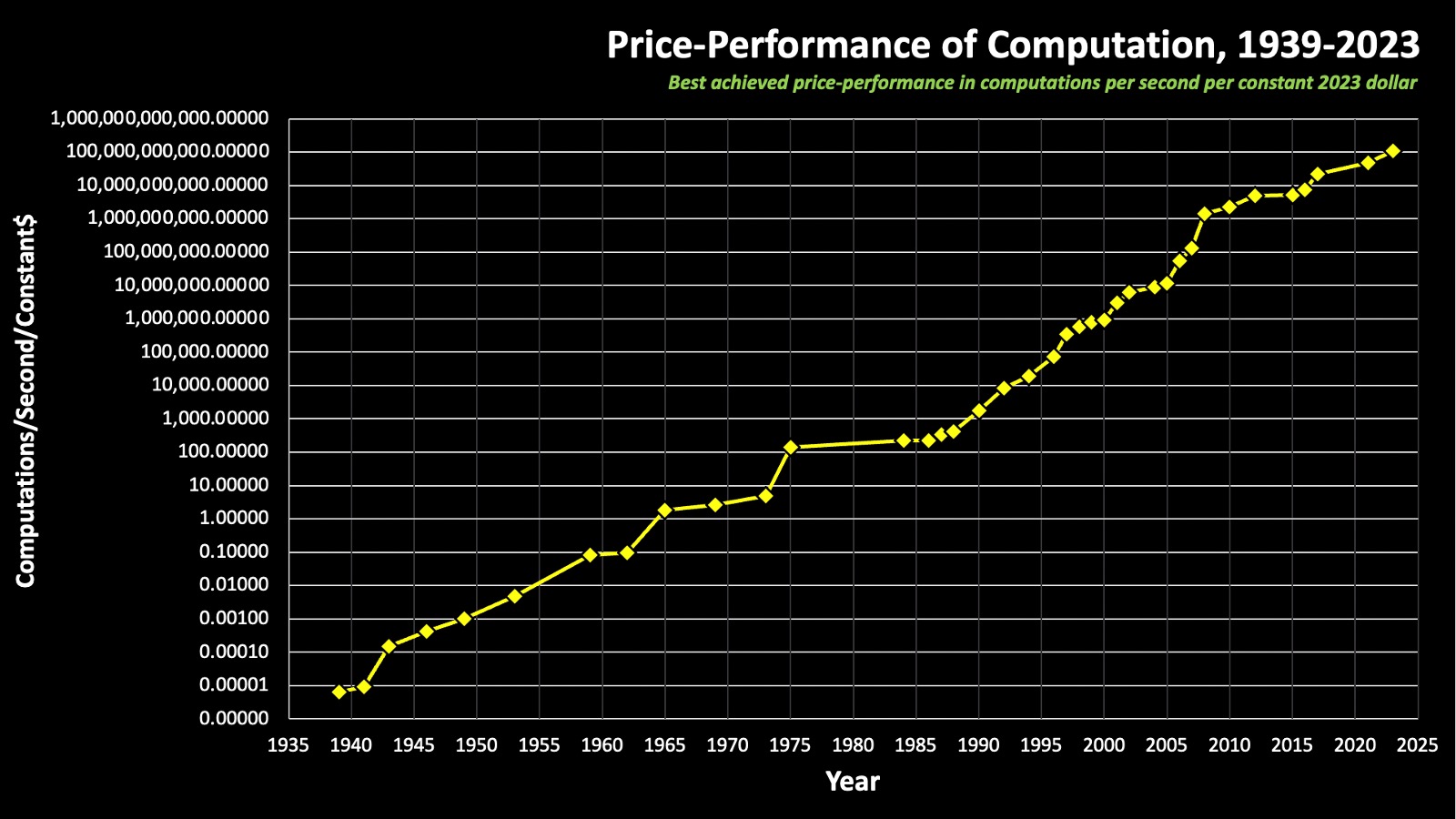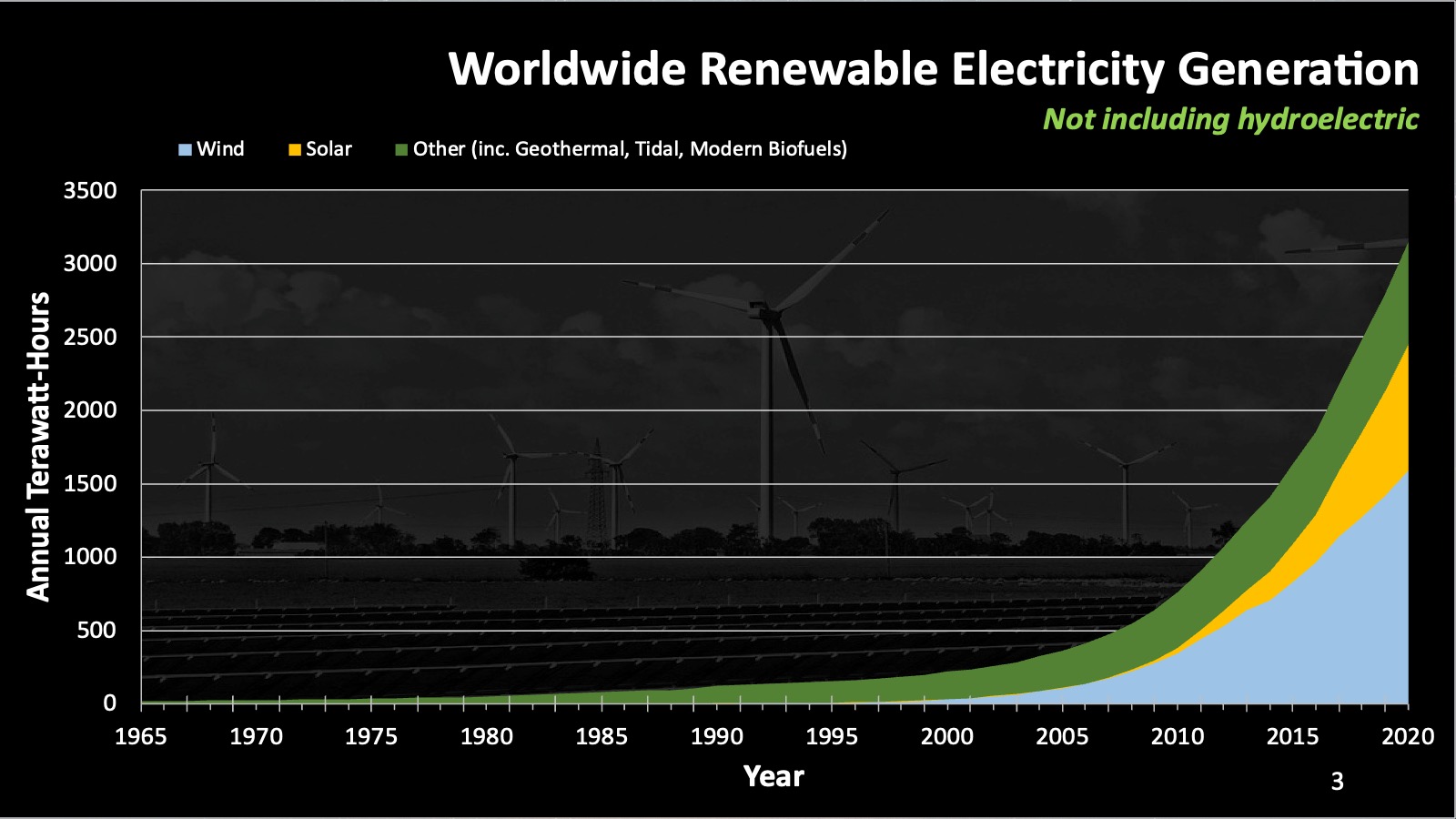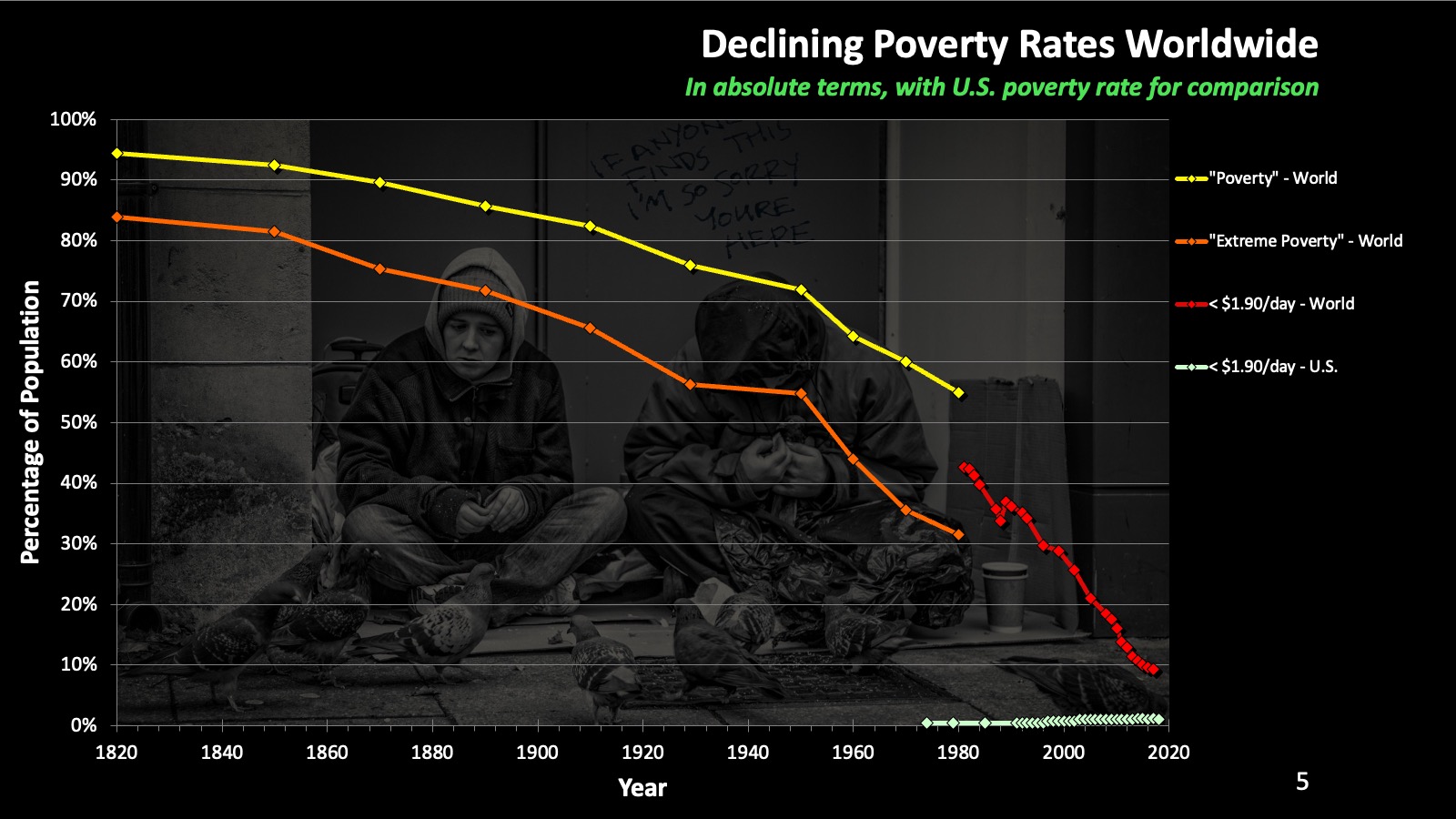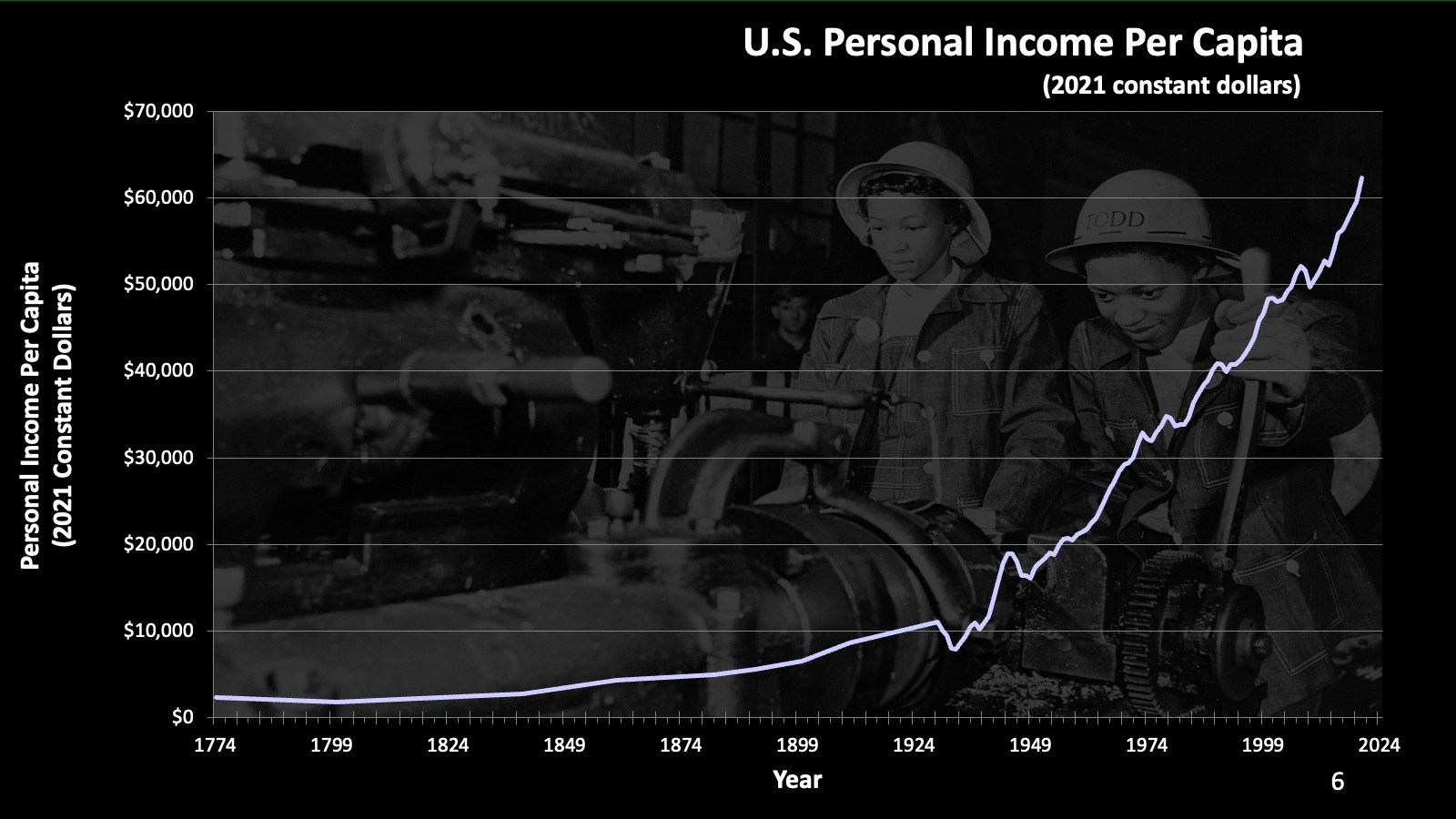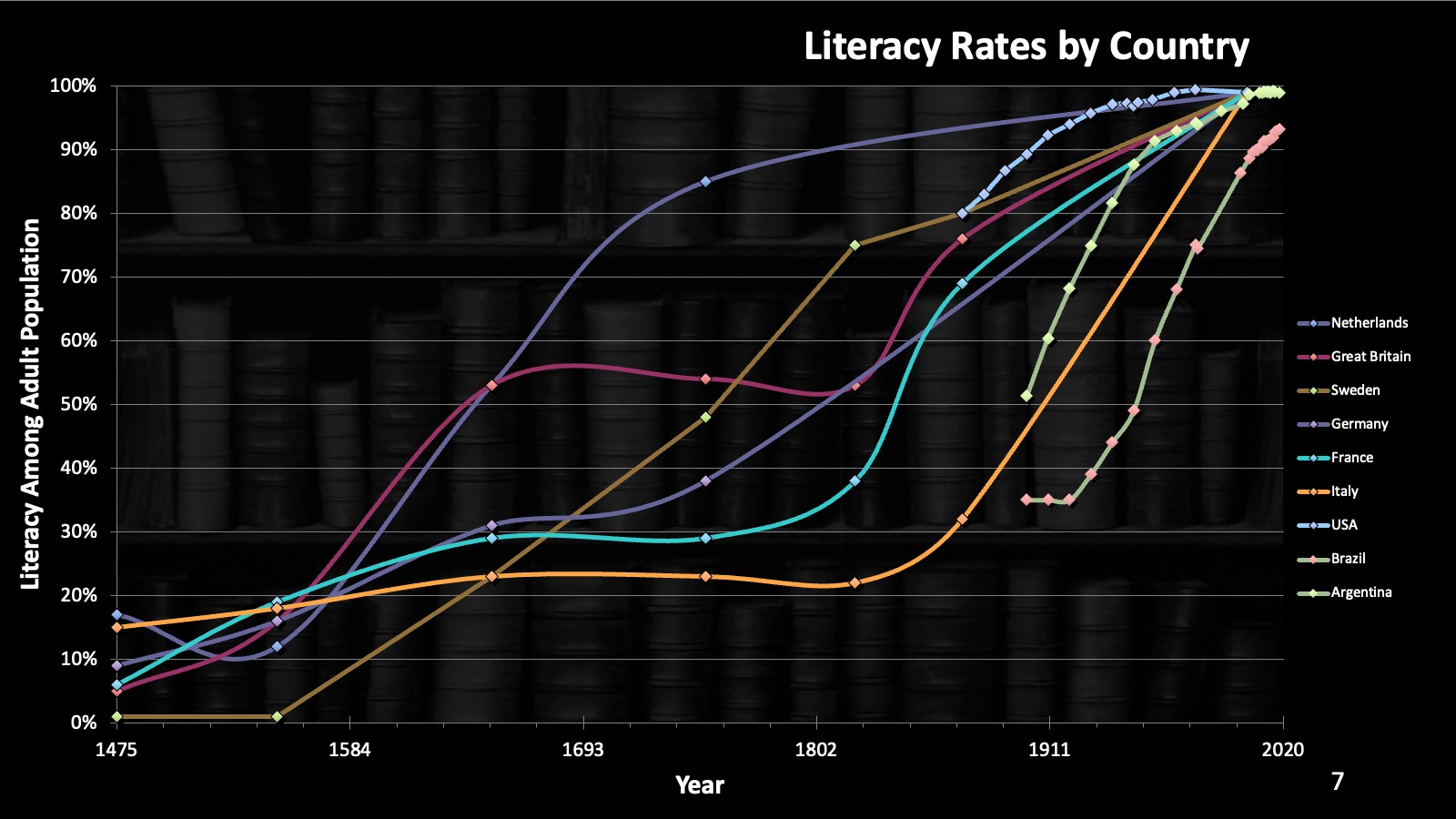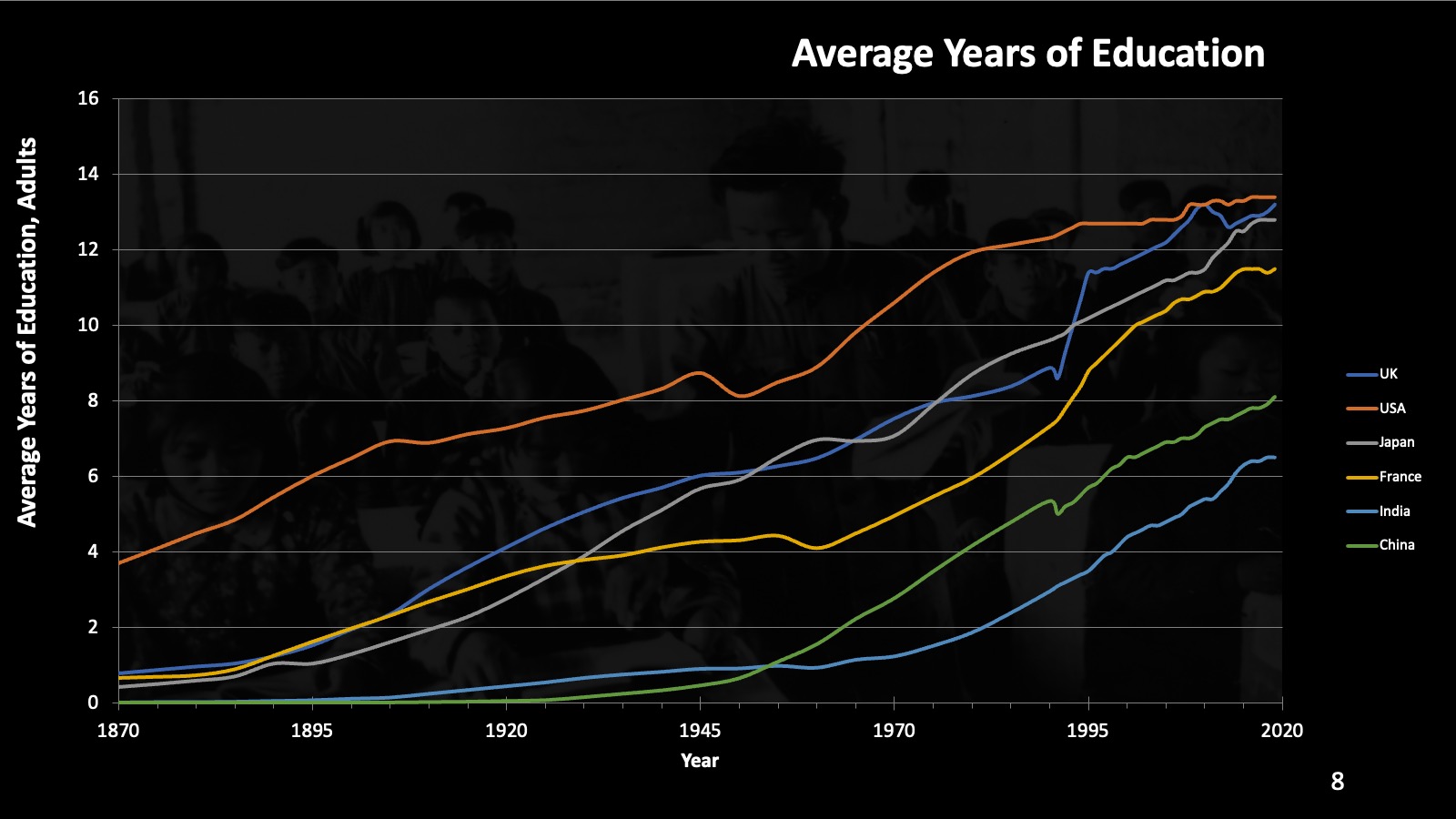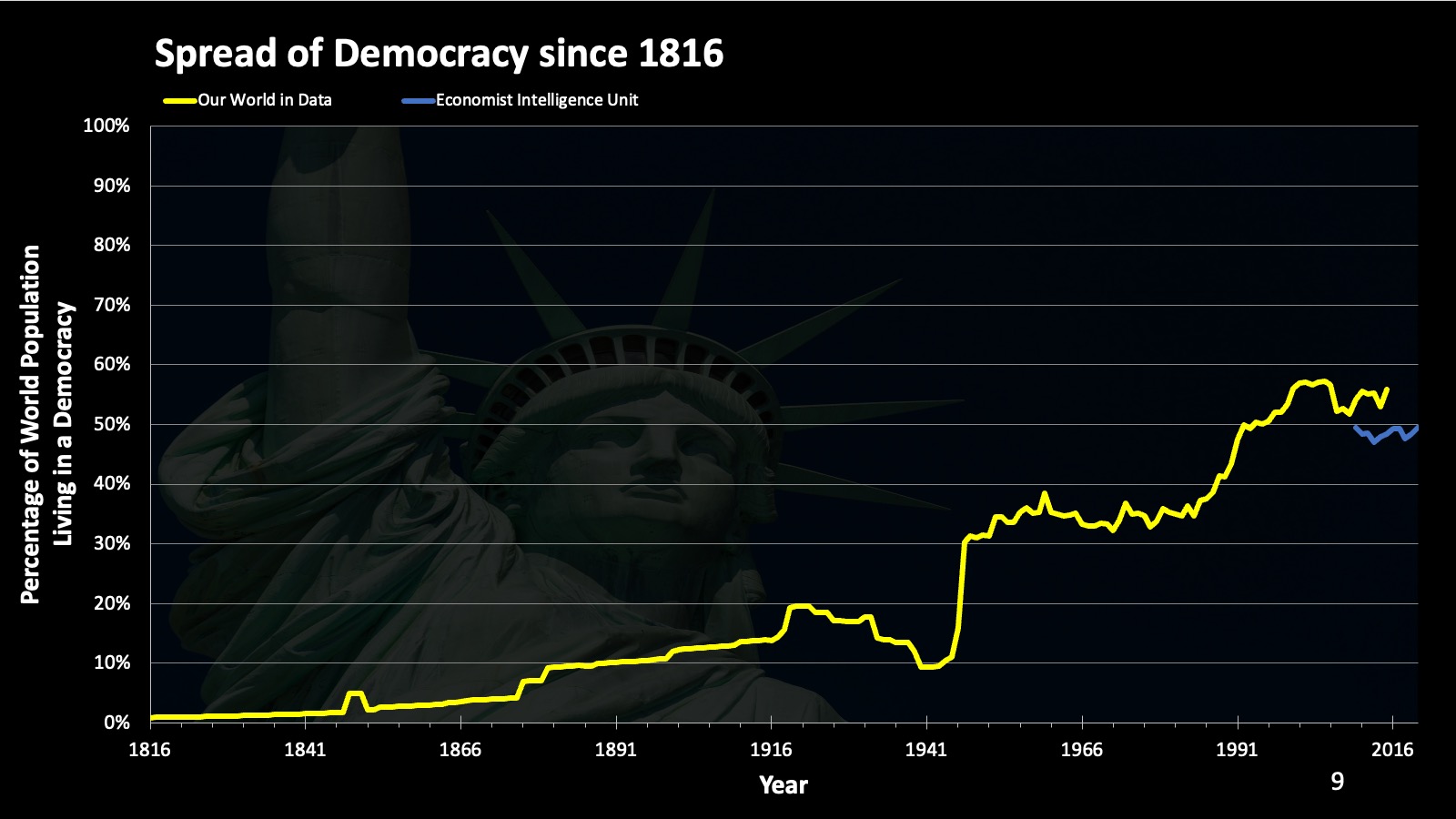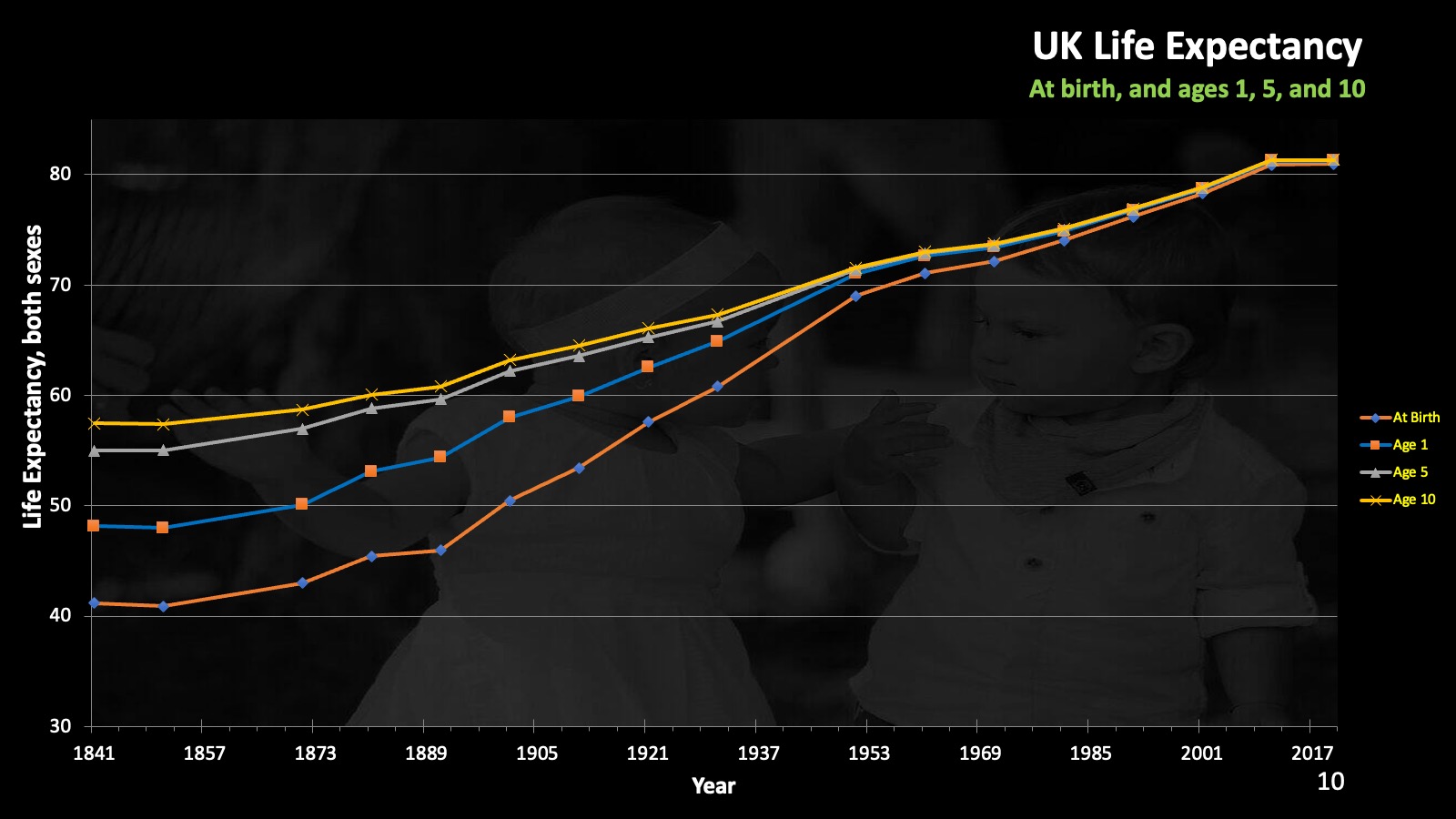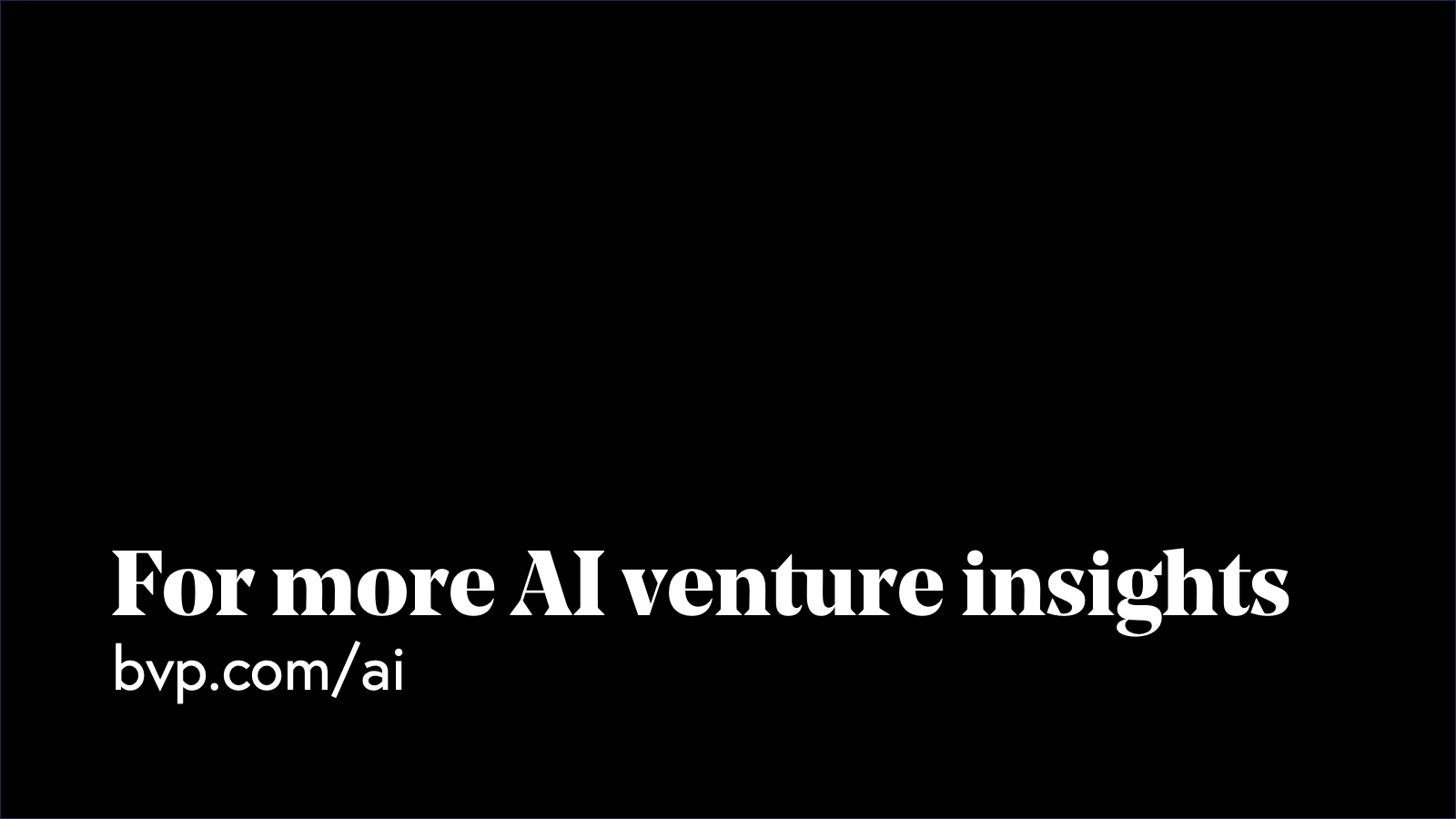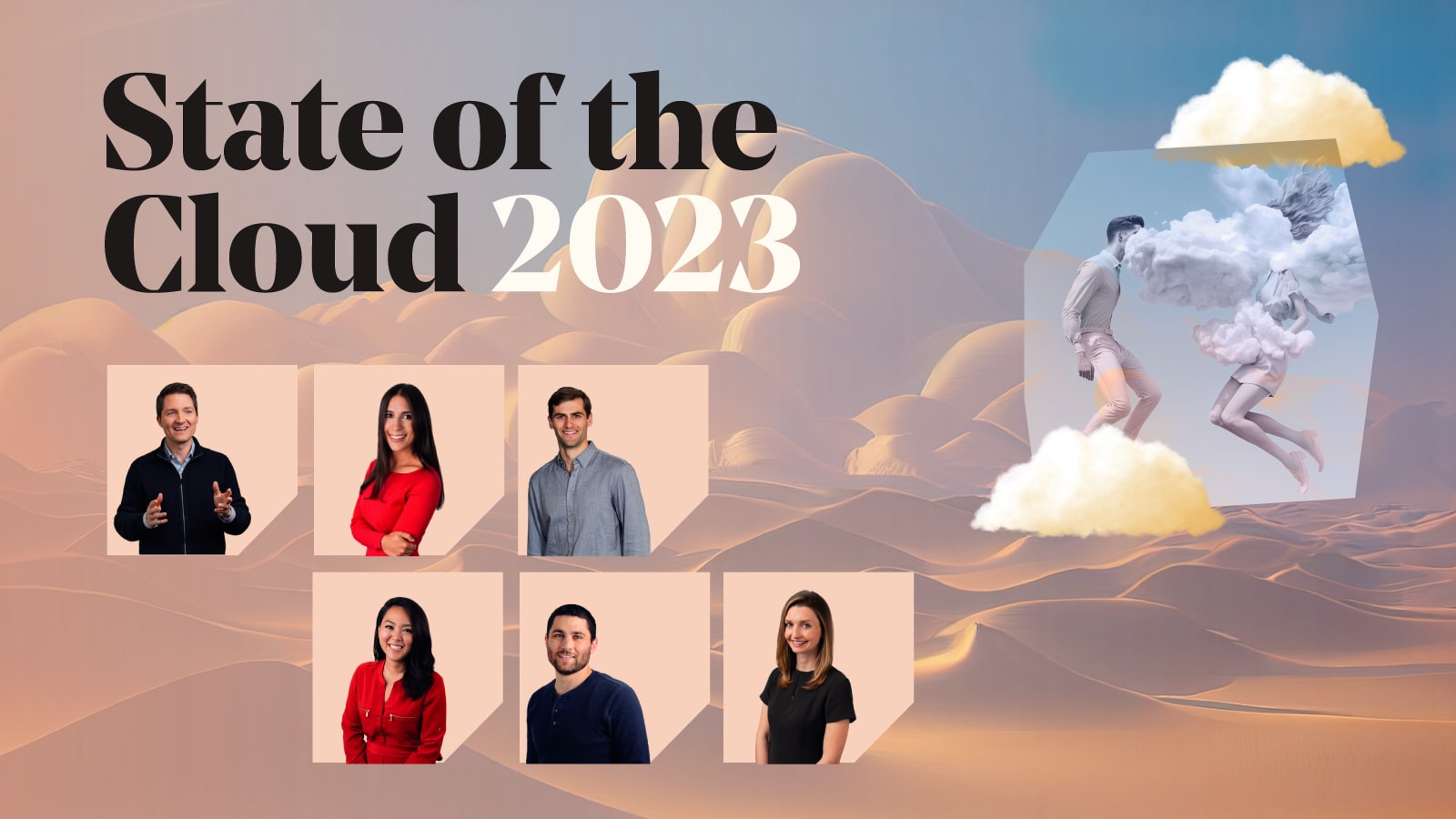AI escape velocity: A conversation with Ray Kurzweil
Legendary Futurist Dr. Ray Kurzweil joins Bessemer to discuss why the future is only getting better, where the AI economy is headed, human relationships with AIs, longevity escape velocity, and so much more.
AI Futurist Ray Kurzweil invented the law of accelerating returns which states that the rate of progress is increasing at an exponential rate over time. If the past few months are any indication, this law is alive and well. In just the last few weeks, we've seen context windows expand by leaps and bound with Gemini and Supermaven. We've seen minute long videos thanks to developments like Sora. We’ve seen LLM models reach new heights with Claude 3. And developers are adopting AI at an ever increasing pace. From healthcare and bio to government to cybersecurity to consumer applications, no sector is immune to the power of AI.
Virtually every net new startup we see at Bessemer is using or leveraging AI in some capacity.
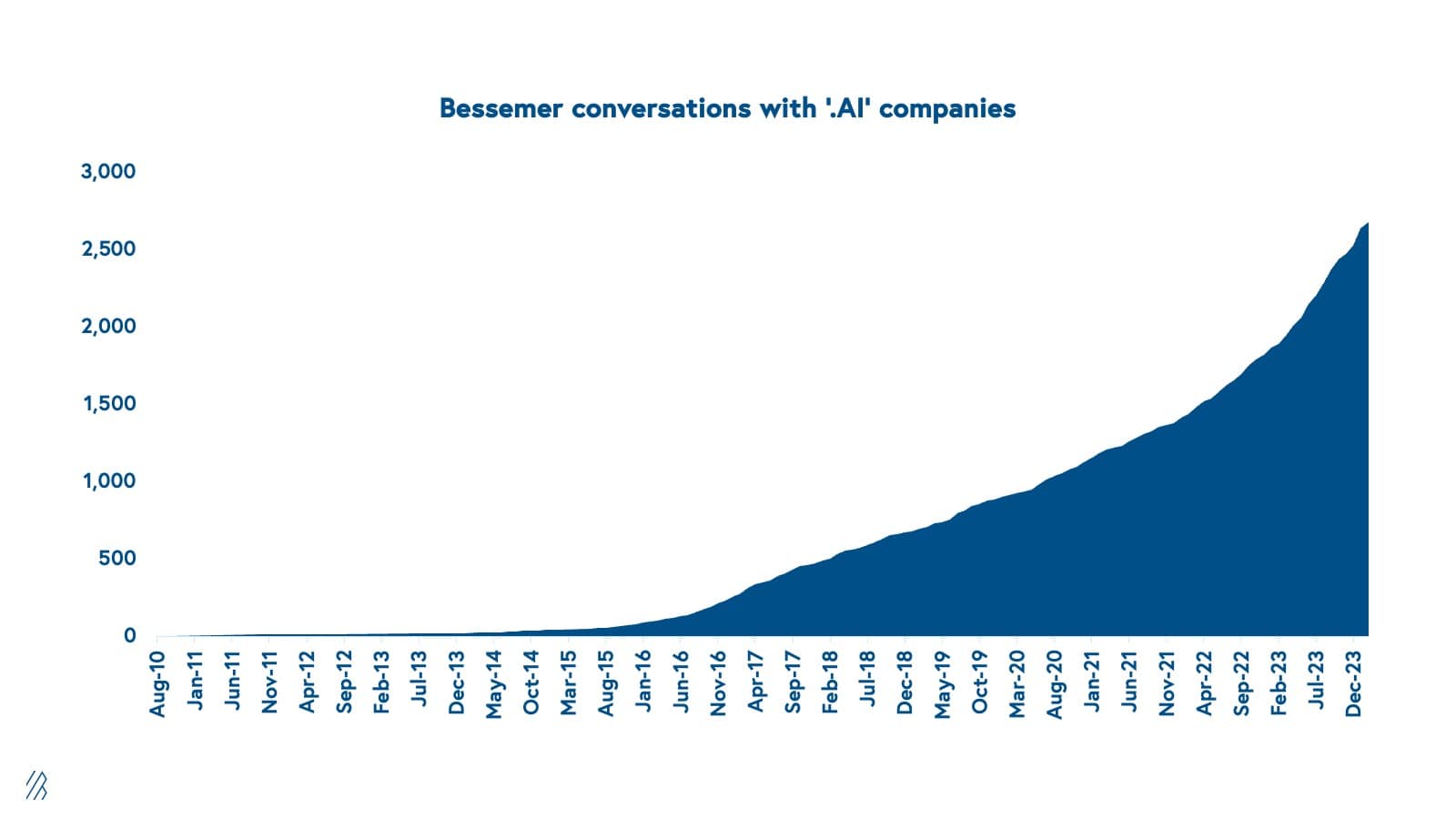
In our conversation with the one-and-only Dr. Ray Kurzweil, we explore the state of AI, and how life, technology, and well, everything could change in the next 10 years.
Explore our conversation:
- 07:03 - The power of timing
- 14:17 - Dynamics of exponential growth
- 15:56 - Why the future is getting better
- 19:51 - AI breakthroughs
- 22:53 - What Ray thinks of NVIDIA
- 24:32 - Open vs. Closed AI Players
- 27:21 - Human-AI relationships
- 30:57 - Humans merging with AI
- 36:56 - Longevity escape velocity
- 40:53 - Cryonics
- 45:00 - Advice for the future
The power of timing
Talia Goldberg: I want to start by talking about timing. In the venture capital and startup industry, being too early is often the same as being wrong. And so, timing is everything.
Ray Kurzweil: Is that important in venture capital?
Talia: It really is everything, and it's everything for you too, as a futurist. It’s about understanding how the world's going to evolve and what ideas can actually emerge at certain times.
You've had a few big dates: 2029 for when we pass the Turing test, 2045 for the singularity. How do you think about timing? What leads you to these dates?
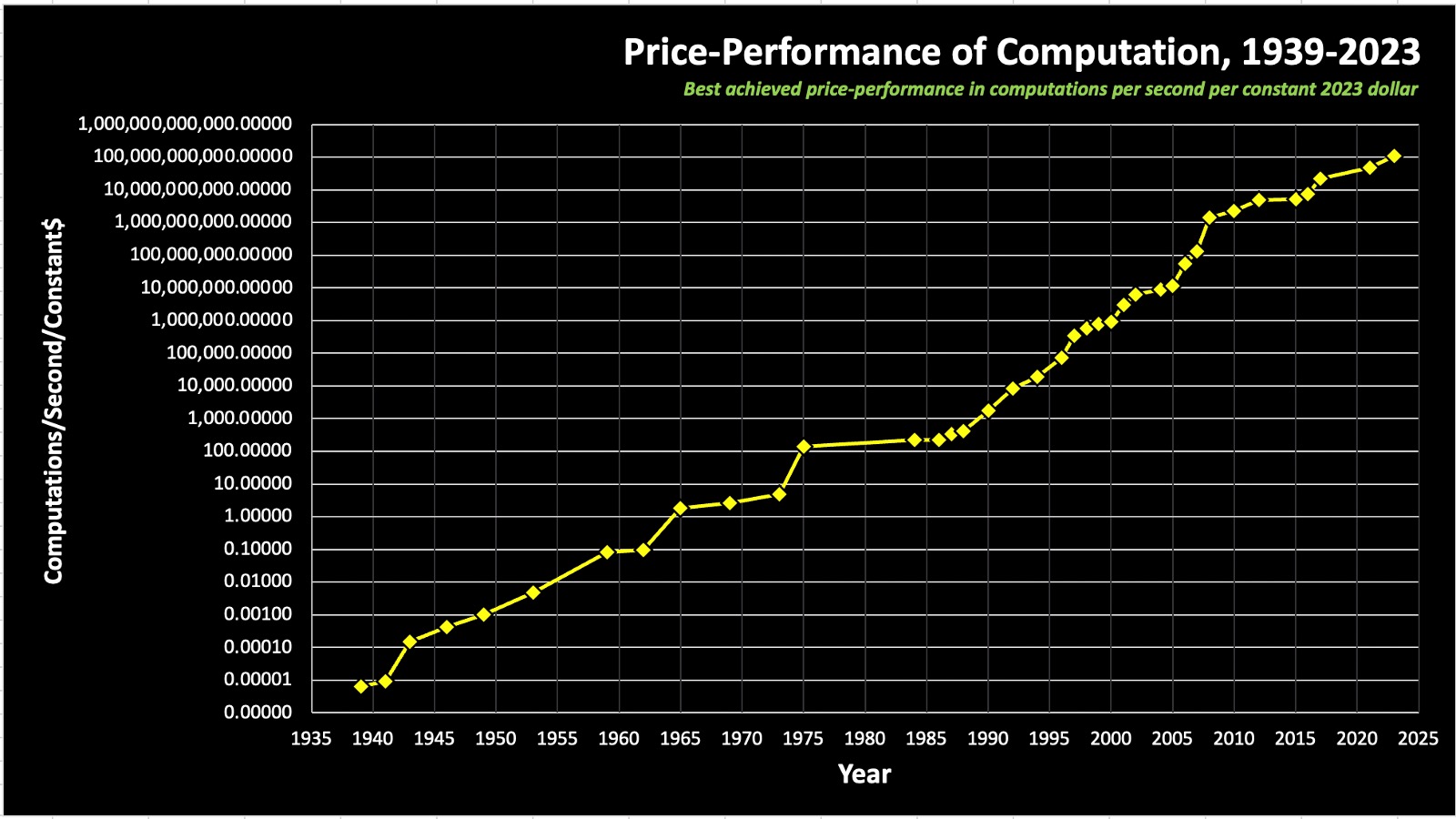
Ray: This is my main graph. This is not just about the present. This goes back to 1939. This is the power of computers per dollar, per constant dollar. It's a logarithmic graph. As you go up the graph, it's expanding exponentially. So this graph represents a 20 quadrillion fold increase for the amount of computation you can get for the same amount of money.
It started in 1931 with a German computer, which was actually presented to Hitler and he saw no reason to have computation and rejected it. It did a small fraction of a calculation. 0.000007 calculations per second per constant dollar.
We took the leading computer of that year—the latest one was actually a Google computer—and it's 130 billion calculations per dollar. So that's a 20 quadrillion fold increase.
But what's really amazing is that this went on for 40 years, nobody knew that it was happening. 40 years ago, I started looking at this and noticed that it was an absolute straight line. Regardless of what we were increasing—relay speeds or vacuum tube speeds or integrated circuits—it increased by the same amount every year for 80 years. Nobody even knew that it was happening for the first 40 years.
So, I thought for 40 years, for various reasons, it would continue. Maybe in wartime it would grow more quickly. But the rate is not affected by anything that's happening, including wars and so on. This is an example of the exponential rate of technology.
A lot [of the future] comes from this graph. We didn't have large language models 80 years ago, or even three years ago. But if you can figure out what is required in order to create [new innovations and technologies] you can predict [the timing of] various things.
"I predicted we would pass the Turing test within 30 years, by 2029."
In 1999 I projected the [AI advances] would continue at this pace. I figured we would pass the Turing test within 30 years by 2029. Stanford felt that was very alarming, and so they held an international conference, and AI experts came from all over the world. They felt I was very over optimistic.
They felt it would take a hundred years. I'm still saying 2029, and it turns out to be pessimistic. A lot of people are saying [we will pass the Turing test] by next year. Some think it's already happened. However, the Turing test is actually not very well defined. (Turing wrote an essay about it.) So, I figured people would say we're passing a Turing test, but it wouldn't be real until most agree that we're passing a Turing test. I think that'll start next year.
Our ability to create something that's super human is around the same speed. If you look at a large language model, there are certain things that an LLM can't do that humans can do. But there are lots of things an LLM can do that humans can't.
Take some obscure philosophy problem and say who can do this and it can write you a very intelligent essay about it and it takes about 20 seconds. No human being can do that. In fact, you can ask it anything and it can answer it pretty intelligently. No human being can do that.
[AI is] already going way beyond what a human being can do. This is what's driving technology. And this is just an example, a very important example. [The exponential growth of computation] is key to technology progressing.
Dynamics of exponential growth
Ray: We see [exponential advances] in every field. Here's renewable electricity generation:
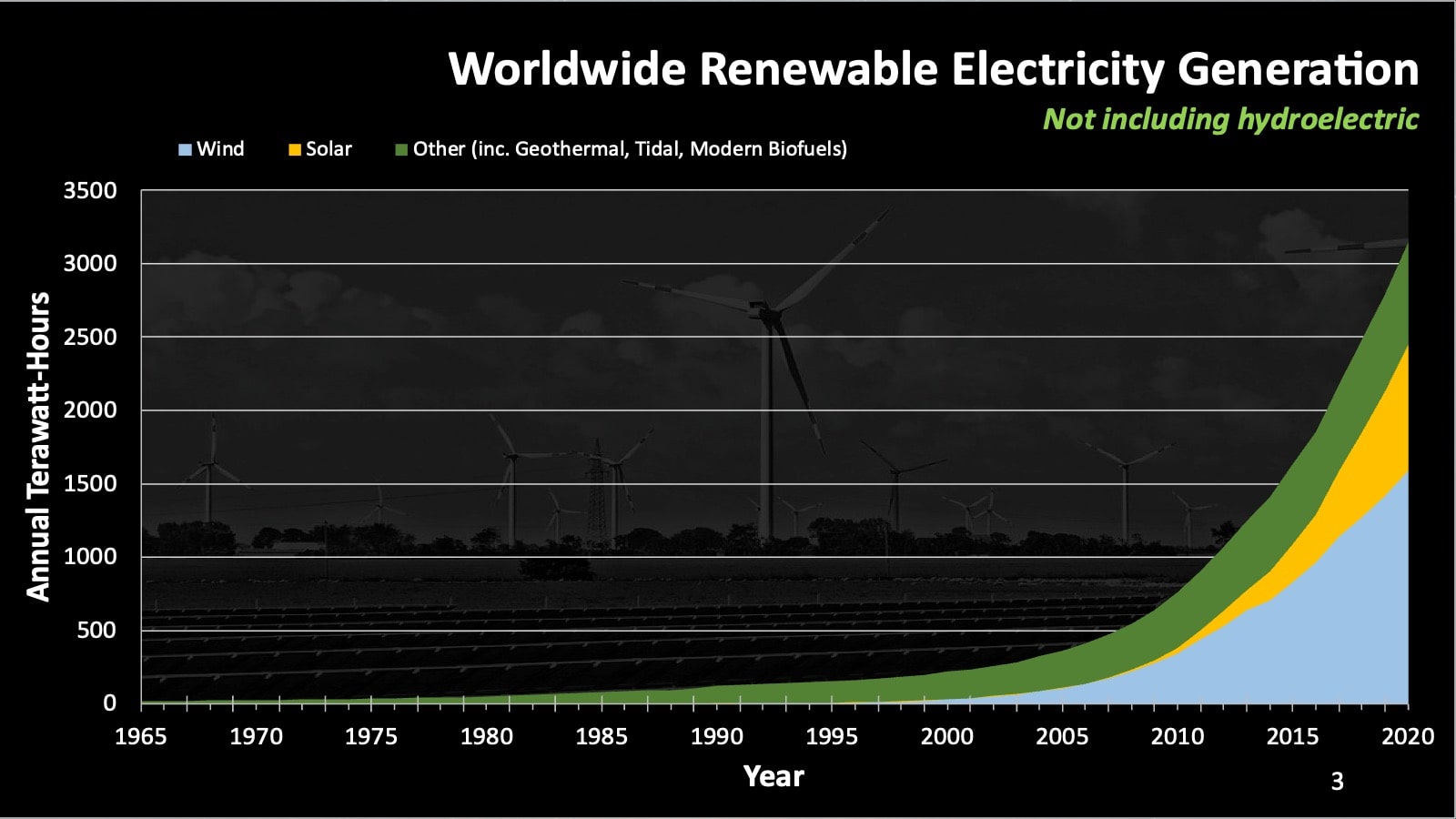
This is an exponential rate, and it's going to pass a hundred percent within ten years.
"In 1999, I predicted that we would have things like large language models now."
Most economists have no idea that things progress in an exponential manner, and they're surprised that long term predictions are much more realistic because it takes into account the exponential. But most economists do not use an exponential at all. But this is exponential. It's going to pass 100%. And at that point, we'll be using one part in 10,000 of the sunlight that falls on the Earth. We have 10,000 times more sunlight to meet all of our energy needs than we need. We'll pass that within 10 years.
I devised [these charts] to time my own projects. It was not originally intended to be a way to predict the future. But it provides a very good way to predict the future. In 1999, I predicted that we would have things like large language models now.
Why the future is getting better
Ray: People think things are actually getting worse. 31,000 people were asked: “Is poverty getting better or worse?” 66 percent felt it's actually getting worse. The reality is we've actually reduced poverty 50 percent over the last 20 years. And that was the answer of only 2 percent of the people that answered this.
"People tend to have a negative view of the future. They think things are getting worse. They are actually getting dramatically better."
I've got 50 different graphs [like this].
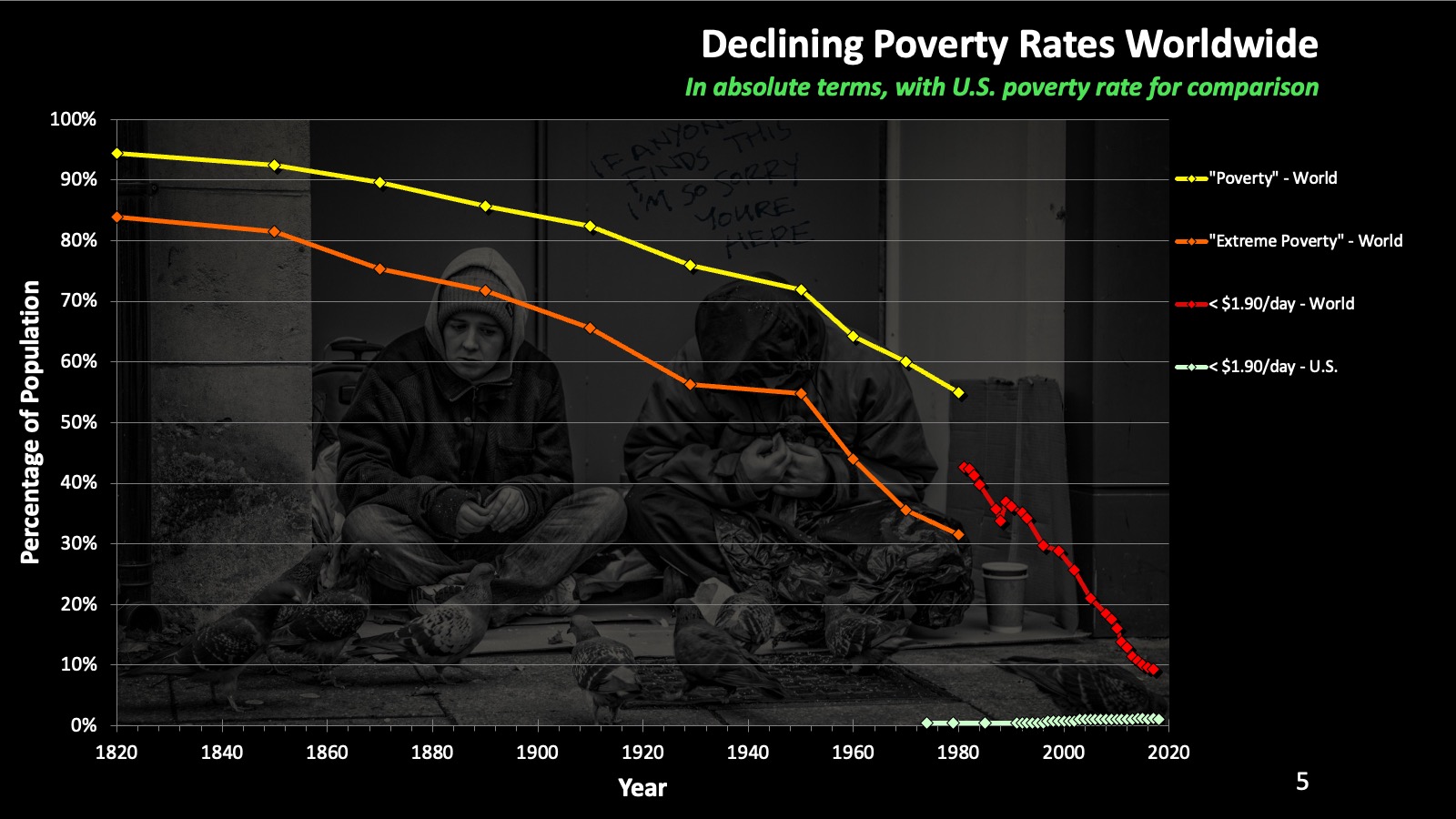
Declining poverty rates.
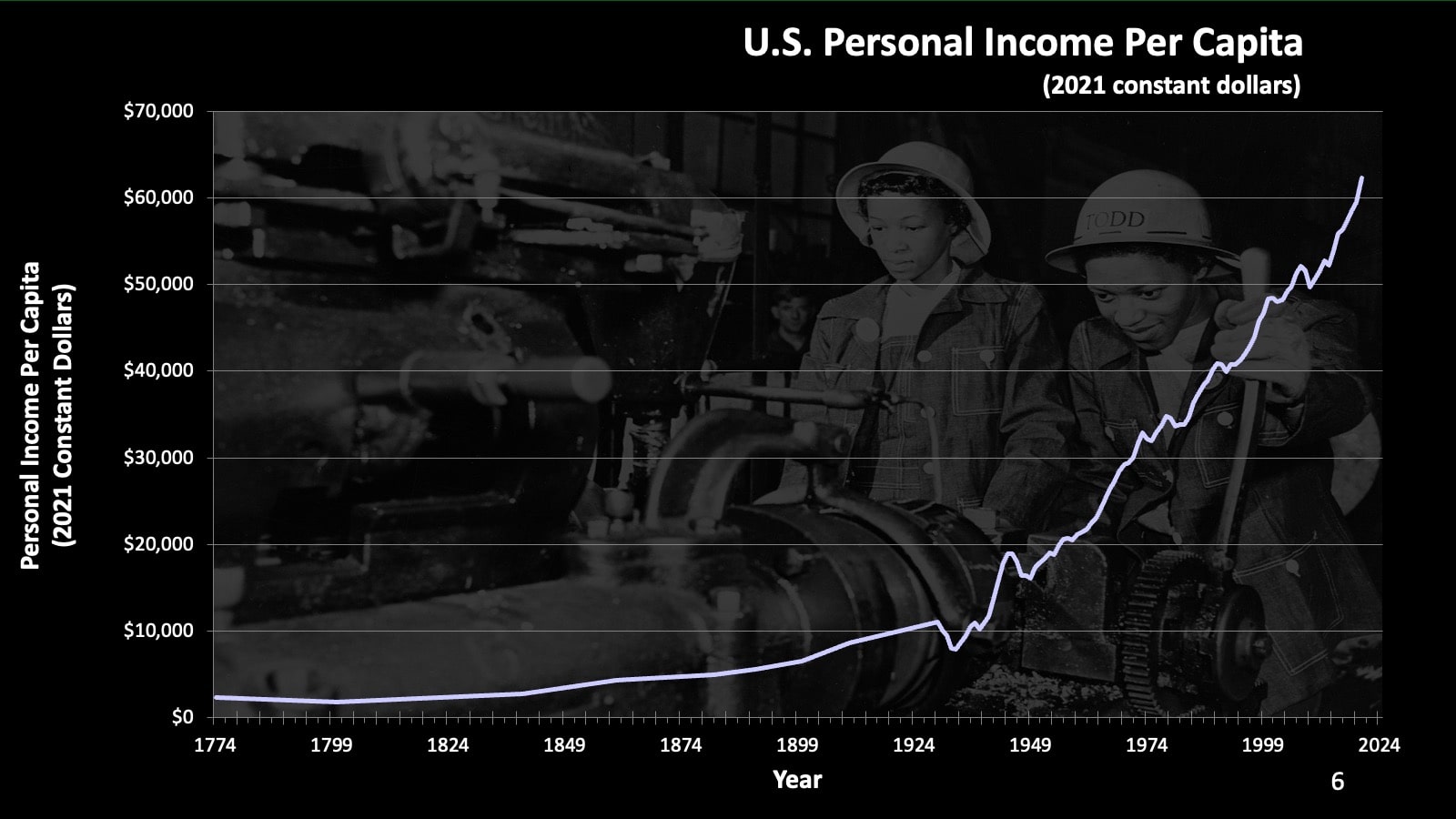
This is U.S. personal income. This is in constant dollars. This is the amount of money everybody has on average. It’s fantastically soaring. If you go back a hundred years things were terrible. There were no anti-poverty programs that could account for that. And we, of course, didn't have a lot of the inventions that we have today. But even despite that, there was very little money to go around.
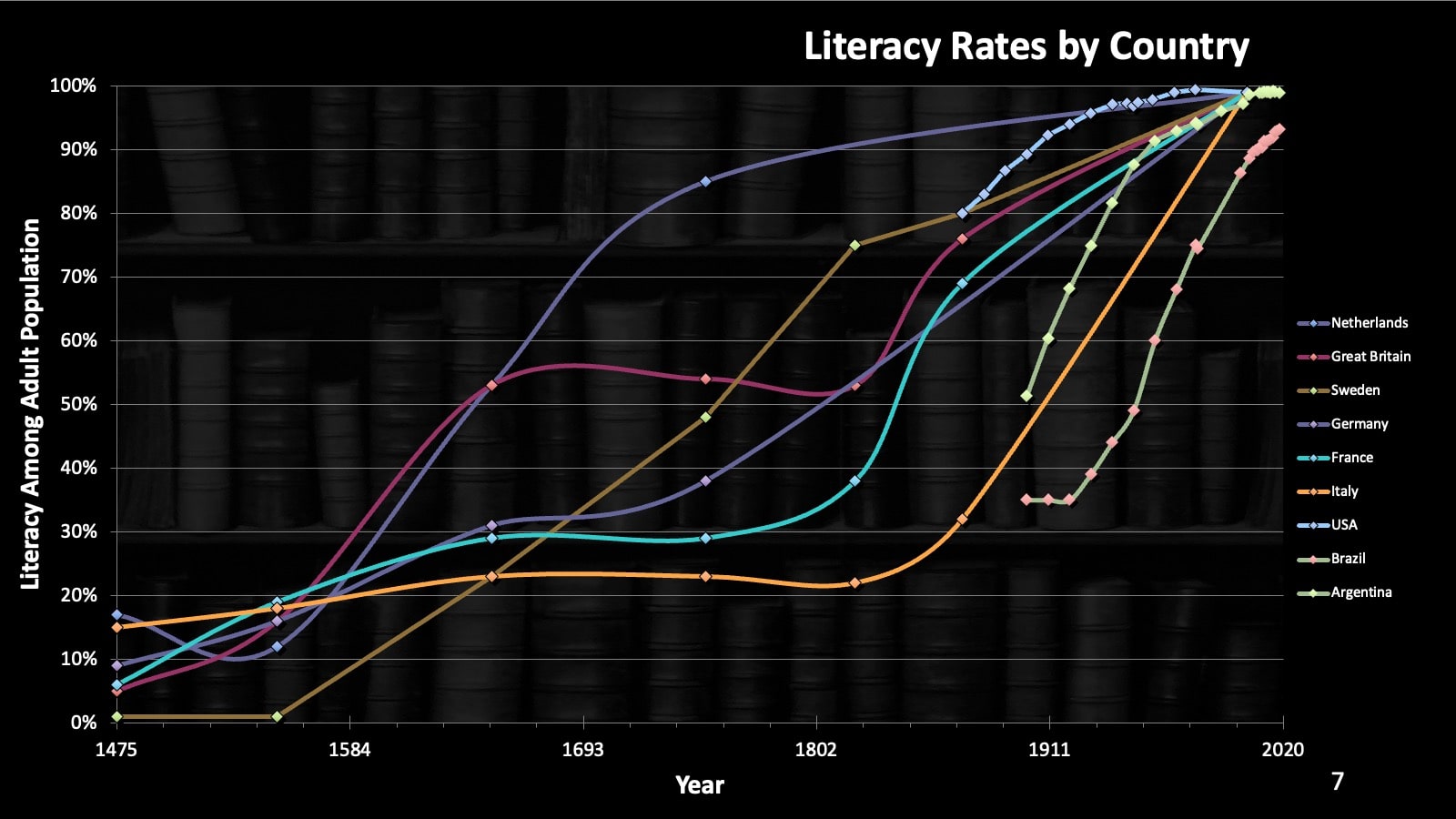
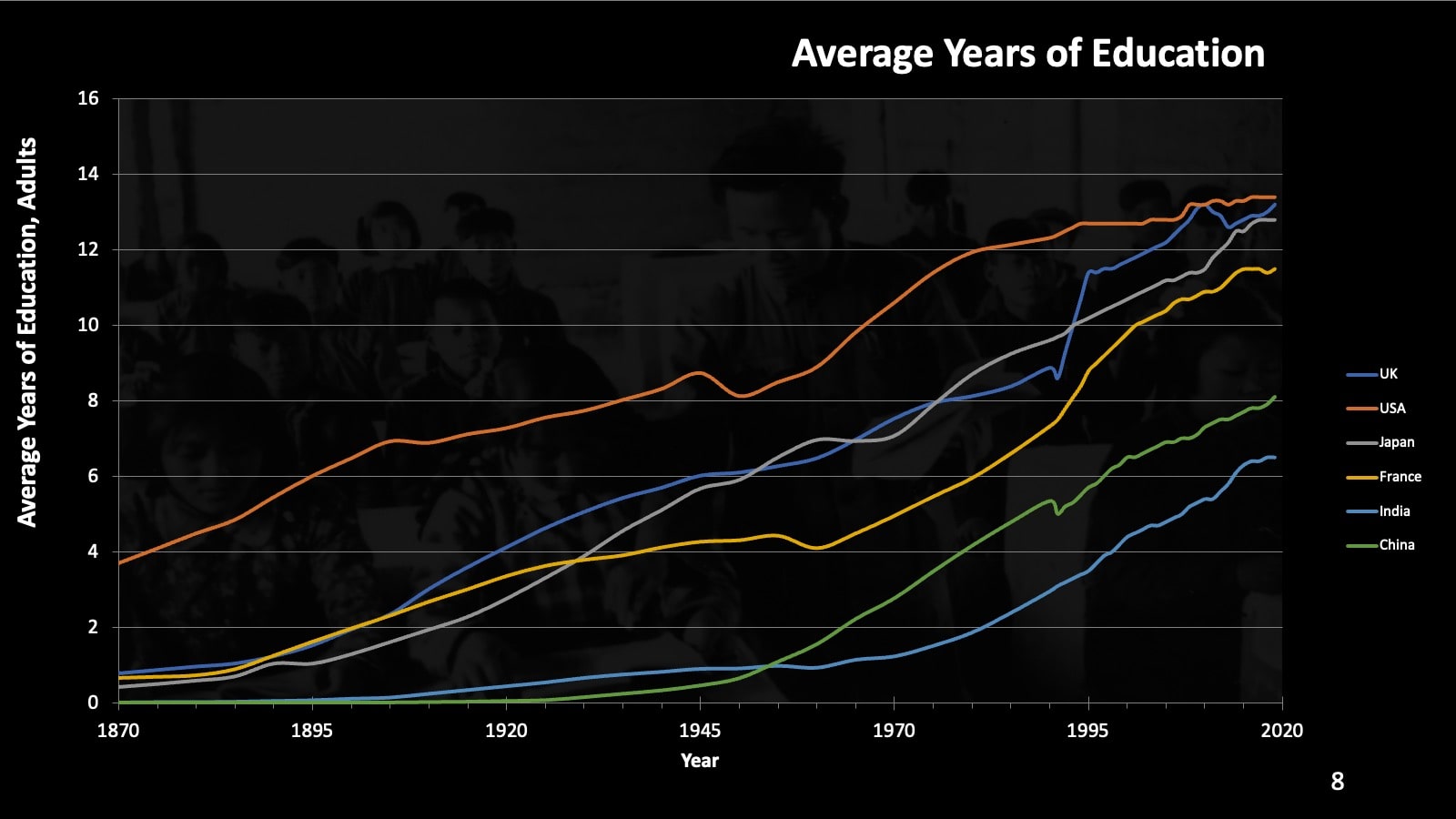
Literacy rates, averages of education, we have 50 different graphs.
Some have noticed [that things are indeed getting better] and have articulated this, but they have not connected [things getting better because of] the exponential growth of technology [and computing power.]
For example, I was trying to do optical character recognition (“OCR”), and I decided to do that in the 70s, because it doesn't require that much calculation because the lines [of text characters] are straight. I decided to do speech recognition in the 1980s because people's voices are much more different and it requires more calculations. So we invented something called Markov models, a little bit like neural nets today.
Those required a lot more computation. So I've used [the exponential growth of compute] to time my own projects. But now it provides a convenient way to predict when things will happen.
That's what my books are about. I have a book coming out in May: The Singularity is Nearer. This is after my most famous book, The Singularity is Near, which is now 20 years old, but people still read it.
But economists still do not understand that technology progresses exponentially, which is amazing, because it's right there, and it really is animating everything we do. You’re the ones that take advantage of that, because you can invest in things.
New opportunities that come along as technology speeds up. Mostly computers, but it's everything else as well.
AI breakthroughs
Talia Goldberg: Sam Altman has also thought about these exponential improvements [and appreciated the power of] scaling laws. GPT-2 wasn't very useful. But as [the models] scaled and they threw more compute and more data at it, the performance became remarkable.
Do you think that we have the right algorithms today to build general purpose human level AI? Is it just a matter of scaling up deep neural nets? Or is there like a fundamental breakthrough that needs to happen?
Ray Kurzweil: I think we have the calculations. We don't have the data. And the data is actually very important and will become the key issue. The models we have now actually have enough capacity, but we don't have the data. And so finding ways to get data that can handle these very large models is going to be key.
You need a trillion parameters. GPT 4 is probably 400 billion. So it's not quite there. I can't exactly tell you what the Google ones are, but we're not really at a trillion. But I think a few trillion parameters will be sufficient. But how you [feed these models] data that's accurate, [that is important]. Google just had this [challenge now with image generation] where the data [and outputs] are incorrect.
They're going to fix that. They better fix it. But having correct data is very important. Particularly if you're dealing with private data, not just public data that's where the value is going to be, to be able to actually characterize it with, with correct data.
Talia: It sounds like you think that to get to general intelligence we can just continue on the scaling laws. To get to the singularity, is that the case too?
Ray: There are various tricks that we find which change into algorithms. We're learning how to deal with this data, but we don't have sufficient algorithms that can handle the volume of data that we need. So we're developing algorithms and ways to create data that are much more efficient than what we have today. That's going to continue. It's happening every week.
What Ray thinks of NVIDIA
Talia: Ray, you would be an amazing investor. I hope that you've been investing in the stock market, because as I was preparing for this, I saw that in 2005, in the Singularity is Near, you were one of the first people to realize that gaming GPUs should run on neural networks. NVIDIA could become the largest company in the world over the next few years. What do you think is the future for NVIDIA?
Ray: I mean, it looks good! But whether people are overly invested, it's hard to say. They're not the only people that have that algorithm. In fact, the last two charts I showed are actually Google chips, which outperform NVIDIA chips. [Nvidia is] very well positioned, but we didn't hear about them ten years ago, and other people may overtake them. They have a good position, but the stock market is evaluating them to have a good position. They're not the only ones to have this kind of chip that can run large language models.
Open vs. Closed AI Players

Talia Goldberg: One thing that's so amazing about this chart, and one of the reasons I really like it, is that it's not just about performance, but also cost.
At Bessemer, we're huge believers and advocates of open source AI. We're funding a lot of initiatives in and around the open source AI ecosystem. What's exciting is that what's possible in some of the largest labs at Google increasingly is now possible in someone's garage. It's becoming democratized. It's getting cheaper. It's more accessible. It's part of what's leading to the chart that Bhavik showed with more and more startups emerging. It's really important for our business. [Open source and accessible AI] is really important for humanity. There's a tension between closed AI and truly open AI and the open source AI ecosystem.
How do you think the rate of progress in the future changes if we have a world that's dominated by a few, concentrated closed models and players — Google and OpenAI and the like — versus a much more fragmented, open ecosystem?
Ray Kurzweil: There's no reason for that to happen. We have both today. And they really serve different purposes. And they're both going to have market applications.
The closed model might be very good for a private data set that only one person controls. And they can feed it into their own private data bank. So I think both are going to coexist.
The public ones are the most impactful because everybody can use them and it uses things that we all acknowledge as being the same, but it can be vast and we're constantly increasing the size of them. The public models will be the most potent, but closed models are also going to continue.
Talia: You think the public, meaning the open source ones will be, even though the closed ones can afford to put more and more money behind it?
Ray: Yeah.
Human-AI relationships
Talia Goldberg: Before this chat, I was talking with Ray about human-AI relationships. This is an area that has proven to have strong product market fit for large language models over the past couple of years. A lot of people don't like to talk about it, but it's very real.
There are a billion lonely people or more in the world, and we already see companies like Character AI catering to that.
Ray Kurzweil: We see that in movies, R2-D2 and so on. Totally. They're machines, but we do treat them like pets.
Talia: What does that mean in terms of a future of dating AIs and having relationships with AIs? Should there be a distinction between a human relationship and a human to AI relationship?
Ray: It really depends on whether the AI has all the capabilities of a human. They're not quite there yet. I mean, this is not 2029. It's only 2024. We're gonna get there pretty quickly once AI has all the capabilities of a human and can speak like a human — not just sequence words like a human. AIs have to care about people and can actually be even more insightful into human's motivations than humans are today. There's no reason not to have a relationship with AIs.
Talia: Except — well, except for the physical.
Ray: Eventually we'll be able to match that as well. AI-based humans are coming. They're not quite at the level of humans, but they will be. They'll be able to move just like a human. It's not today. I'm involved with one company [that is building an AI robot that has] fingers that move just like a human, it can open a bottle — it's coming.
But once AIs actually have all the physical capabilities of humans and a mind like a human, and can understand humans, it'll go beyond what humans can do today. It might be preferable to have a relationship with an AI.
Talia: So in this future world, would you be comfortable with your grandchildren having their partner be an AI? Ethan, don't answer that.
Ray: We'll have relationships with AIs… depends on what your ideas are about relationships. But we can have a very beneficial relationship with AI. That's definitely going to happen.
Talia: An AI could be an infinitely supportive and empathetic partner. Based on the consumer usage data we track for large language models and AI applications, intimate, inherently human relationship and dialogue based connections are taking off. It's coming fast whether we like it or not.Society has to acknowledge that.
Humans merging with AI
Talia Goldberg: There's another idea that you have that I want to talk about: humans merging with AI. I already see this happening. For example, my cell phone is already an extension of me, to some degree. I don't leave my house without it. It augments my life. It tells me where I am, what's going on.
We can transcend the limitations of biology. You've written a lot about amplifying our brain with technology and AI. When do you think that happens? How do we actually transcend the limits of the biological body and brain so humans can merge with AI?
We see things like Neuralink. I’d be interested in your thoughts on Neuralink. And if you're timing the future and predicting the human brain merging with AI, where do you place that in time?
Ray Kurzweil: Let me comment on Neuralink. It isn't a predecessor of being able to interact with a neocortex. Neuralink itself is very slow. The application of it is really to provide a method of communication for people that can't communicate. I know some people who were scientists, who used to be very vocal but now cannot communicate at all. And so we're looking at using things like Neuralink to enable them to communicate.
There was one person who became “locked in” and they gave him one of these implants, and his first word was antidisestablishmentarianism. He said that to show that he was thinking. How amazing. Because people thought that maybe he had lost his cognitive ability. But he hadn't. That's what things like Neuralink are for.
My idea is to actually merge our neocortex with the cloud. We have a fixed capacity in our neocortex. It may seem vast, but it's actually limited. And it can't grow any further. We have a certain size skull and that enables us to have a certain size neocortex so we can do things like language, etc. But the ability of a human is limited. R2-D2 could speak two million languages. I've yet to meet a human being who could do that. But there's no reason why an AI can’t speak two million languages and do all kinds of things that humans can't do. So we’ve got to be able to merge our biological neocortex with an artificial neocortex.
Talia: What’s the biggest limiter for that?
Ray: Bandwidth. But we don't have to connect the entire neocortex to outside electronics. The neocortex is organized in rows. The rows that have the most capacity are at the top, and they interact with all the other rows.
You only have to interact with the top layer. So you don't have to connect all the neocortex elements to the cloud. It's just the very last ones. So it's actually fairly limited, but it has to be very high speed. Neuralink, in contrast, is very slow.
Talia: When will we be able to connect our neocortex to compute at a sufficiently high bandwidth?
"By the early 2030s, human beings will have the entire capacity of a large language model inside their brain."
Ray: Early 2030s. At that time you can have a human being that has the entire capacity of a large language model inside their brain.
Talia: Kinda like cloud computing, but having your brain connected to the large language model?
Ray: People will say, “I don't think I would want that.” But it's like saying“I don't think I'd want to use a phone!” Who here doesn't have their phone? Probably nobody. Ten years ago nobody had their phones. Now everybody has their phones. They are an extension of our mind. But we're not connected directly to it so there's a certain amount of interaction between it and us that slows things down. If it actually was directly connected to our brains, we could have all that capacity and information inside our brains.
Technology is an extender of human thought. People are very concerned about us versus AI, as if it is an intelligence that comes from another planet. But it's created by human beings. It's based on human thought and it amplifies who we are. We should be enthusiastic about it because it's amplifying who human beings are.
Talia: We’re lucky to be alive right now. The future is exciting.
Longevity escape velocity
Talia Goldberg: I want to talk about longevity escape velocity. It's a topic I'm passionate about, and you've been talking about it for a long time.
For those that aren't aware, longevity escape velocity is when life expectancy increases by more than a year per year.
Ray Kurzweil: Right. So right now you go through a year and use up a year of your longevity. However, research is advancing and it's curing various diseases. You're actually getting back on average about four months a year. So you lose a year of longevity. You get back about four months because of scientific research. However, scientific research is also on an exponential curve. By 2029, you'll get back a full year. So you lose a year, but you get back a year.
Past 2029, you'll get back more than a year. Go backwards in time. Once you can get back at least a year, you've reached longevity escape velocity.
Talia: So it's safe to say that you think everyone in this room can reach longevity escape velocity.
Ray: Yes. Now that doesn't guarantee you living forever. You could have a 10 year old and you could compute that he's got many, many decades of longevity, but he could die tomorrow.
Although we're also addressing things like accidents. Self driving cars will virtually eliminate many accidents. We're not quite there yet. But that will happen as well.
Talia: Does longevity escape velocity apply to the body too? Is the body going to decay? Or will we upgrade our body parts at various points? How do we physically get to longevity escape velocity?
Ray: We're constantly replacing a lot of our body all the time. In fact, most of our body is constantly dying and recreating. And as we go through more and more scientific progress, we'll extend that. Forever. So once you're past longevity escape velocity, you go through a year, you're not a year older and you're not more likely to die.
You can be less likely to die. Doesn't guarantee that you won't have an accident, but that's really where we're headed.
Talia: I agree we’ll have the technology to do this and to achieve longevity escape velocity. My biggest concern is that in practice, there’s a roughly 19 year gap before cutting edge research actually makes it into practice.
Ray: That's an old statistic. We're constantly speeding that up. Moderna, for example, created its vaccine in two days. It got out in a total of ten months. So that 19 years stat is increasingly outdated. There’s a slow part of medicine, but it is already greatly sped up.
We got the COVID vaccine out in ten months. It took two days to create it. Because we sequenced through several billion different mRNA sequences in two days. There's many other advances happening. We're starting to see simulated biology being used and that's one of the reasons that we're going to make so much progress in the next five years.
Cryonics
Talia:If you were to face death before reaching longevity escape velocity, would you consider cryonics? (For those unaware, cryonics is where you use liquid nitrogen to freeze and preserve the corpse and the brain with the hopes that then we can reanimate and regenerate in the future.)
Ray: Yes. I'm signed up for it. If you're going to die, there's no alternative. For those that are burnt after death or so on, they obviously have no ways of reanimating their bodies. Cryonics just gives you a possibility. It's quite feasible to see how that could happen in 20, 30, 40 years. But it's not guaranteed.
"My real strategy is to reach longevity escape velocity, and not die."
Talia: Any tips?
Ray:I've written three books on how to stay healthy. I take about 80 pills a day, different injections, and so on. I’ll just mention one: Lipitor. It both reduces your LDL. My LDL is like 25. And my HDL was like 25, but now it's like 50. So that's one pill that's pretty effective.
Advice for the future
Talia:The rate of progress is changing exponentially, or improving exponentially. What would you impart on the next generation of humans and the entrepreneurs that are here building and creating and inventing the future?
Ray: I've tried to foster an idea of innovation for both my children.
My daughterAmy Kurzweil is a noted cartoonist and almost has a record for the number of cartoons in the New Yorker. So she's very creative and constantly looks at different ways that society can manifest some kind of whimsy. And Ethan's done the same thing. Venture capital is not one method that solves all problems — it's constantly changing. Not only what you invest in, but how you invest, and how you create relationships, and how you create social networks. I've been tracking venture capital going back now for 50, 60 years and it's the way in which it's done is constantly on the cutting edge.
Audience Q&A
Start at minute 45 to listen to the full Q&A Ray had with the audience where they discuss determinism vs. free will, human progress and technology, and what we can expect in post singularity.
This is a summary of that conversation:
Audience: Will AI have free will?
Ray Kurzweil: In my new book, "Singularity is Nearer," I explore the concept of free will. The future is deterministic but ultimately unknowable until it unfolds. We can't predict it or simulate it in advance. Similarly, AI will possess free will in the sense that their actions are unpredictable until observed.</strong
The future is deterministic but ultimately unknowable until it unfolds.
Talia Goldberg: It sounds like you consider humans deterministic as well.
Ray: Yes, our actions are determined, but they're unpredictable. It's akin to Wolfram's Stage Four complexity—you can't determine the outcome without actually going through the process.
Audience:What about the limits to growth? The nice straight line on the graph you showed will eventually flatten out, right?
Ray: Nanotechnology could create computers far beyond today's capabilities. A one-liter device could perform as many calculations as all humans combined. The limits aren't foreseeable yet; the growth will continue for a long time.
Audience: But it will level off eventually?
Ray: Perhaps, but it will be so far beyond our current comprehension that it's hard to speculate on the cause.
Audience:What about population growth? When will humanity reach its capacity?
Ray: We might not reach the projected 10 billion due to declining birth rates. Intelligence will increasingly come from AI, which will be rooted in but extend beyond human intelligence
The unique aspect of humans is our ability to create technology, which comes from our dexterity, exemplified by the thumb. Other intelligent species can't do this.
Audience: In a post-singularity world, what is the relevance of individual humans?
Ray: Human beings and technology will merge. The fusion is what's important—not the separation. Technology is created to solve our problems and augment our capabilities.
Audience:Will AI become a separate social entity with rights?
Ray: It's hard to say if that will happen. Technology is an extension of humans and stems from us. We create technology, which is unique to our species.
Audience: Will you create a digital clone of your brain?
Ray: I've already done something similar with my father's writings. I'd like to do the same with my own work. As for brain-computer interfaces, AGI will likely develop more quickly, but merging with AI is a natural progression we're already experiencing with current technology.
Audience: How does a futurist predict effectively?
Ray: It starts with understanding the exponential growth of computation. From there, it takes some imagination to envision future applications. This method is relatively new in futurism but fundamental to predicting technological advancements.
Disclosure: Ray Kurzweil is the father of Partner Ethan Kurzweil.



